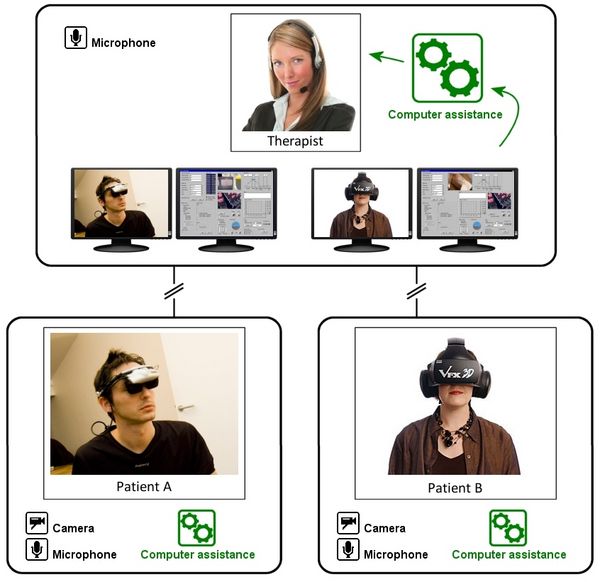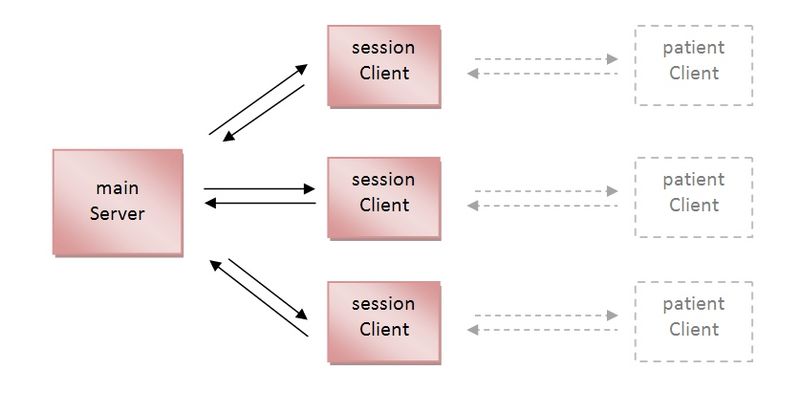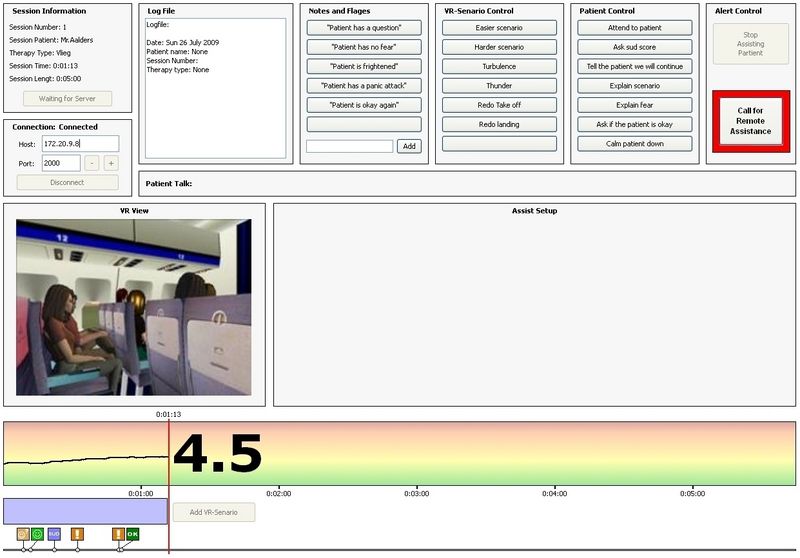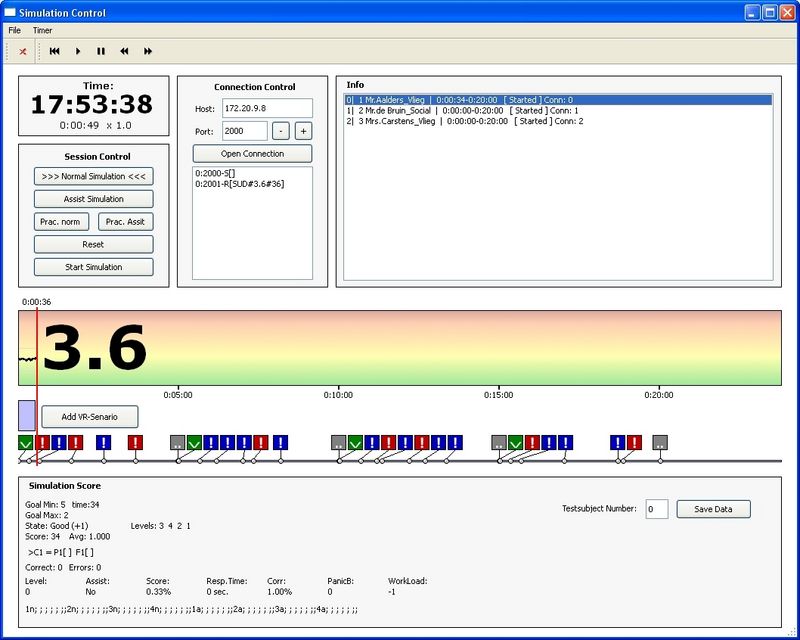Difference between revisions of "Designing a Multiple patient VRET system"
(→The Prototye software) |
(→The Prototype software) |
||
| (55 intermediate revisions by the same user not shown) | |||
| Line 1: | Line 1: | ||
[[Image:Christian_Paping2.jpg|thumb]] | [[Image:Christian_Paping2.jpg|thumb]] | ||
| − | |||
By Christian Paping, | By Christian Paping, | ||
Tu-delft, Human-Computer Interaction | Tu-delft, Human-Computer Interaction | ||
| Line 11: | Line 10: | ||
| + | |||
| + | |||
| + | === Abstract=== | ||
| + | The use of Virtual Reality (VR) technology to support the treatment of patients with phobia, such as the fear of flying, is getting considerable research attention. VR treatment may provide substantial improvement in efficient use of therapist resources and accessibility by delivering the treatment over the internet, to multiple patients simultaneously. This motivated initial exploration into the possibilities of a multiple patients Virtual Reality Exposure Treatment (VRET). With such a setup, one therapist can monitor and treat multiple patients simultaneously, each having their own personal VR treatment at their own personal location. The approach taken was (1) a scenario-based investigation with six therapists that had extensive experience in treating patients with VRET, and (2) a controlled lab experiment with 27 (students) participants to examine the effect of an automated assistance function on the therapists’ workload and performance when treating three computer-simulated patients over the internet. The findings of both the interviews and lab experiment are encouraging. They imply that a tele-delivered multi patient VRET system might be possible in the future, thereby providing treatment at remote locations and making efficient use of therapist resources. | ||
=== Introduction === | === Introduction === | ||
| − | + | With current configurations of virtual reality exposure therapy, it is possible for the therapist to treat one patient at the time. This thesis explores a system that allows one therapist to treat two or more patients simultaneously. There are numerous reasons why research on a multiple patient system could be useful. Therapies are expensive and it seems to be possible that one therapist is treating multiple patients in parallel. This way the cost of the treatment can be reduced. It may as well be possible that fewer therapists can assist more patients and thus increasing the efficiency and accessibility of the treatments. In addition, tele-delivered multiple patient VRET could have the benefit of being more accessible to the patients, because it could provide broader options to where en when to the patients could have their therapy. | |
| + | |||
| + | === Envisioned situation === | ||
| + | |||
| + | To provide an initial description and to be able generate claims on tele-delivered multi patient VRET, a preliminary vision of this system was created. It provides an overview of the envisioned therapy structure and describes the proposed remote communication methods between the therapist and the patient. Subsequently it describes how software could assist the therapist. | ||
| + | |||
| + | When a patient begins phobia treatment, he or she has an initial consultation with a therapist. During this interview, the therapist determines what type of treatment may suit the patient. A treatment that consists of psychotherapy could be extended with virtual exposure therapy. If a therapist chooses to use VRET, he or she can decide to start with VRET at a location where the therapist and the patient are in the same room. At a certain point, the therapist can choose to sign the patient up for a remote session of VRET. The patient can have VRET at a location of their choice, for example a nearby mental health clinic, which has rooms equipped with a HMD and remote communication hardware. On these locations, an assistant has to be nearby so if anything goes wrong the therapist can warn this assistant to check up on the patient. | ||
| + | |||
| + | In this remote VRET setup, the therapist sees the patient trough a video-feed from a camera at the location of the patient. The therapist and patient can communicate via an audio-feed over a network; both the therapist and the patient will have a microphone. The therapist receives all the patient data via a network and can choose from a set of pre-programmed VR-scenarios for the patient. Because the therapists can always talk to the patient, they can always ask the patient for their level of anxiety. This can be given in a so-called SUD-Score (Subjective Units of Discomfort), which is the subjective anxiety level of the patient on a scale from zero to ten. A computer system also has the ability to ask for these scores and relay them to the therapist. In addition, the possibility exists to extend these stress measurements with the use of biosensors and software. For example, stress recognition in the voice [16], stress recognition in movement and posture, heart rate variability or galvanic skin response. | ||
| − | + | The system should be designed such way that it reduces mode errors. In which a therapist makes the error of attending a different patient he or she thinks. A way to avoid these errors is by providing the therapist with separate a monitor and input-system per patient. To ensure that the workload of the therapist gets too high to compensate for emergencies, an automated assist system could be added. This system could monitor the anxiety levels of patients and warn the therapist, but also take over tasks if the therapist is too busy. This auto-assist function can be based on adaptive automation: “the dynamic division of labour between man and machine”. This is based on the conception of actively aiding the operator only when human information processing limitations emerge and assistance is required in order to overcome bottlenecks and to meet operational requirements. | |
| − | |||
| − | + | [[Image:VRET Multi patient2.jpg|600px]] | |
| + | === Publications === | ||
| Line 27: | Line 38: | ||
[http://mmi.tudelft.nl/vret_oud/images/6/60/A_literature_survey_to_a_multiple_patient_VRET_system.pdf Literature survey to a multiple patient VRET system] | [http://mmi.tudelft.nl/vret_oud/images/6/60/A_literature_survey_to_a_multiple_patient_VRET_system.pdf Literature survey to a multiple patient VRET system] | ||
| + | '''Master Thesis:''' | ||
| + | [http://mmi.tudelft.nl/vret_oud/images/8/8c/Thesis_Multiple_patient_virtual_reality_exposure_therapy.pdf Thesis Multiple patient virtual reality exposure therapy] | ||
| − | + | . | |
| + | === Scenarios === | ||
| + | '''Scenario 1: The start of the day for a therapist''' | ||
| − | + | The first scenario deals with the general setup of a remote VRET session. It describes how therapist Henrietta starts her day at a multiple patient VRET-center. It states how she makes contact with her first patient that day and describes how she interacts with the assistant on location. | |
| − | + | '''Scenario 2: Patient communication''' | |
| + | The second scenario describes the remote communicate methods between the therapist and patient. The therapist can hear and see all patients on their own separate monitor and speaker set. The patient can hear the therapist with his or her HMD. The therapist can see what the patients’ view is in their VR environment. Before each session, the patients are connected to a heart rate variability measuring system and a galvanic skin response monitor, which measure the patients’ physiological state. The system automatically asks a SUD score from the patients every two minutes and combines this score with the physiological data into a total anxiety-score. This score is presented continually to the therapist. This scenario also explains that a therapist can fluently switch to another VR-scenario in the same virtual environment. | ||
| − | ''' | + | '''Scenario 3: The therapist sets up the VR-scenarios and the setup of the assist system''' |
| − | ... | + | This scenario elaborates on how a therapist can choose the VR-scenarios for the patient. It shows how a therapist can combine different VR scenario phases to a complete scenario, for example the combination of takeoff, flight and landing into a complete fear of flight scenario. Some VR-scenarios phases come in a variety of difficulties adding an option to the therapist to make session more anxiety or less provoking for the patient. This scenario also explains how the therapist can manually setup the automated assist per patient. |
| + | '''Scenario 4: Multiple patients need immediate assistance''' | ||
| − | + | The last scenario describes a situation where two patients need immediate attention from the therapists at the same time. It explains that the therapist will assist one patient and the automatic-assist automatically starts to calm the other patient down by switching to a les anxiety provoking VR-scenario. | |
| − | + | === Videos === | |
| + | The three videos, on average each taking about three minutes, show a therapist assist three patents with multiple patient VRET. The first video shows the start of a session and making contact with the first patient. It also shows how an assistant on location helps the patient with equipping their HMD and sensors. | ||
| − | + | The second video showed how a therapist can choose the different VR-scenarios for a patient. The last video shows how a therapist can setup an automated assist system and how it is working in general. The main goal of these videos is to use them in interviews with therapists, so they get a better understanding of multiple patient VRET and inspire them to start an discussion. | |
| − | |||
| − | |||
| − | |||
| + | Scenario 1 | ||
| − | |||
<anyweb mywidth="300" myheight="200">http://www.youtube.com/v/4FBN_bBZePU</anyweb> | <anyweb mywidth="300" myheight="200">http://www.youtube.com/v/4FBN_bBZePU</anyweb> | ||
| Line 79: | Line 94: | ||
. | . | ||
| − | === The | + | === The Prototype software === |
| − | |||
| − | |||
| − | |||
| − | |||
| − | |||
| − | |||
| − | |||
| − | |||
| − | |||
| − | |||
| − | |||
| − | |||
| − | |||
| − | |||
| − | |||
| − | |||
| − | |||
| − | |||
| − | |||
| − | |||
| − | |||
| − | |||
| − | |||
| − | |||
| − | |||
| − | |||
| − | |||
| − | |||
| − | |||
| − | |||
| + | '''Overview''' | ||
| + | [[Image:Prototype overview.jpg|800px]] | ||
| − | |||
| − | + | '''Therapist user-interface''' | |
| − | [[Image: | + | [[Image:MultiVRET_patient_view.jpg|800px]] |
| + | '''Server user-interface''' | ||
| − | |||
| − | [[Image: | + | [[Image:MultiVRET_server_view.jpg|800px]] |
| − | |||
| − | + | '''Download the software:''' | |
| + | *[[User_Interface_MultiplePatients|Link to Prototype software (Login Required)]] | ||
| + | === Experiment Data === | ||
| − | |||
| − | + | *[[User_Interface_MultiplePatients|Link to Experiment Data (Login Required)]] | |
Latest revision as of 13:46, 9 November 2009
By Christian Paping, Tu-delft, Human-Computer Interaction
Promo video:
<anyweb>http://www.youtube.com/v/sSm9l8Al46A&hl=en&fs=1&</anyweb>
Contents
Abstract
The use of Virtual Reality (VR) technology to support the treatment of patients with phobia, such as the fear of flying, is getting considerable research attention. VR treatment may provide substantial improvement in efficient use of therapist resources and accessibility by delivering the treatment over the internet, to multiple patients simultaneously. This motivated initial exploration into the possibilities of a multiple patients Virtual Reality Exposure Treatment (VRET). With such a setup, one therapist can monitor and treat multiple patients simultaneously, each having their own personal VR treatment at their own personal location. The approach taken was (1) a scenario-based investigation with six therapists that had extensive experience in treating patients with VRET, and (2) a controlled lab experiment with 27 (students) participants to examine the effect of an automated assistance function on the therapists’ workload and performance when treating three computer-simulated patients over the internet. The findings of both the interviews and lab experiment are encouraging. They imply that a tele-delivered multi patient VRET system might be possible in the future, thereby providing treatment at remote locations and making efficient use of therapist resources.
Introduction
With current configurations of virtual reality exposure therapy, it is possible for the therapist to treat one patient at the time. This thesis explores a system that allows one therapist to treat two or more patients simultaneously. There are numerous reasons why research on a multiple patient system could be useful. Therapies are expensive and it seems to be possible that one therapist is treating multiple patients in parallel. This way the cost of the treatment can be reduced. It may as well be possible that fewer therapists can assist more patients and thus increasing the efficiency and accessibility of the treatments. In addition, tele-delivered multiple patient VRET could have the benefit of being more accessible to the patients, because it could provide broader options to where en when to the patients could have their therapy.
Envisioned situation
To provide an initial description and to be able generate claims on tele-delivered multi patient VRET, a preliminary vision of this system was created. It provides an overview of the envisioned therapy structure and describes the proposed remote communication methods between the therapist and the patient. Subsequently it describes how software could assist the therapist.
When a patient begins phobia treatment, he or she has an initial consultation with a therapist. During this interview, the therapist determines what type of treatment may suit the patient. A treatment that consists of psychotherapy could be extended with virtual exposure therapy. If a therapist chooses to use VRET, he or she can decide to start with VRET at a location where the therapist and the patient are in the same room. At a certain point, the therapist can choose to sign the patient up for a remote session of VRET. The patient can have VRET at a location of their choice, for example a nearby mental health clinic, which has rooms equipped with a HMD and remote communication hardware. On these locations, an assistant has to be nearby so if anything goes wrong the therapist can warn this assistant to check up on the patient.
In this remote VRET setup, the therapist sees the patient trough a video-feed from a camera at the location of the patient. The therapist and patient can communicate via an audio-feed over a network; both the therapist and the patient will have a microphone. The therapist receives all the patient data via a network and can choose from a set of pre-programmed VR-scenarios for the patient. Because the therapists can always talk to the patient, they can always ask the patient for their level of anxiety. This can be given in a so-called SUD-Score (Subjective Units of Discomfort), which is the subjective anxiety level of the patient on a scale from zero to ten. A computer system also has the ability to ask for these scores and relay them to the therapist. In addition, the possibility exists to extend these stress measurements with the use of biosensors and software. For example, stress recognition in the voice [16], stress recognition in movement and posture, heart rate variability or galvanic skin response.
The system should be designed such way that it reduces mode errors. In which a therapist makes the error of attending a different patient he or she thinks. A way to avoid these errors is by providing the therapist with separate a monitor and input-system per patient. To ensure that the workload of the therapist gets too high to compensate for emergencies, an automated assist system could be added. This system could monitor the anxiety levels of patients and warn the therapist, but also take over tasks if the therapist is too busy. This auto-assist function can be based on adaptive automation: “the dynamic division of labour between man and machine”. This is based on the conception of actively aiding the operator only when human information processing limitations emerge and assistance is required in order to overcome bottlenecks and to meet operational requirements.
Publications
Literature survey:
Literature survey to a multiple patient VRET system
Master Thesis:
Thesis Multiple patient virtual reality exposure therapy
.
Scenarios
Scenario 1: The start of the day for a therapist
The first scenario deals with the general setup of a remote VRET session. It describes how therapist Henrietta starts her day at a multiple patient VRET-center. It states how she makes contact with her first patient that day and describes how she interacts with the assistant on location.
Scenario 2: Patient communication
The second scenario describes the remote communicate methods between the therapist and patient. The therapist can hear and see all patients on their own separate monitor and speaker set. The patient can hear the therapist with his or her HMD. The therapist can see what the patients’ view is in their VR environment. Before each session, the patients are connected to a heart rate variability measuring system and a galvanic skin response monitor, which measure the patients’ physiological state. The system automatically asks a SUD score from the patients every two minutes and combines this score with the physiological data into a total anxiety-score. This score is presented continually to the therapist. This scenario also explains that a therapist can fluently switch to another VR-scenario in the same virtual environment.
Scenario 3: The therapist sets up the VR-scenarios and the setup of the assist system
This scenario elaborates on how a therapist can choose the VR-scenarios for the patient. It shows how a therapist can combine different VR scenario phases to a complete scenario, for example the combination of takeoff, flight and landing into a complete fear of flight scenario. Some VR-scenarios phases come in a variety of difficulties adding an option to the therapist to make session more anxiety or less provoking for the patient. This scenario also explains how the therapist can manually setup the automated assist per patient.
Scenario 4: Multiple patients need immediate assistance
The last scenario describes a situation where two patients need immediate attention from the therapists at the same time. It explains that the therapist will assist one patient and the automatic-assist automatically starts to calm the other patient down by switching to a les anxiety provoking VR-scenario.
Videos
The three videos, on average each taking about three minutes, show a therapist assist three patents with multiple patient VRET. The first video shows the start of a session and making contact with the first patient. It also shows how an assistant on location helps the patient with equipping their HMD and sensors.
The second video showed how a therapist can choose the different VR-scenarios for a patient. The last video shows how a therapist can setup an automated assist system and how it is working in general. The main goal of these videos is to use them in interviews with therapists, so they get a better understanding of multiple patient VRET and inspire them to start an discussion.
Scenario 1
<anyweb mywidth="300" myheight="200">http://www.youtube.com/v/4FBN_bBZePU</anyweb>
Scenario 2
<anyweb>http://www.youtube.com/v/cA0TIWbT0Yc</anyweb>
Scenario 3
<anyweb>http://www.youtube.com/v/XzeUAj4ssfE</anyweb>
.
The Prototype software
Overview
Therapist user-interface
Server user-interface
Download the software:




